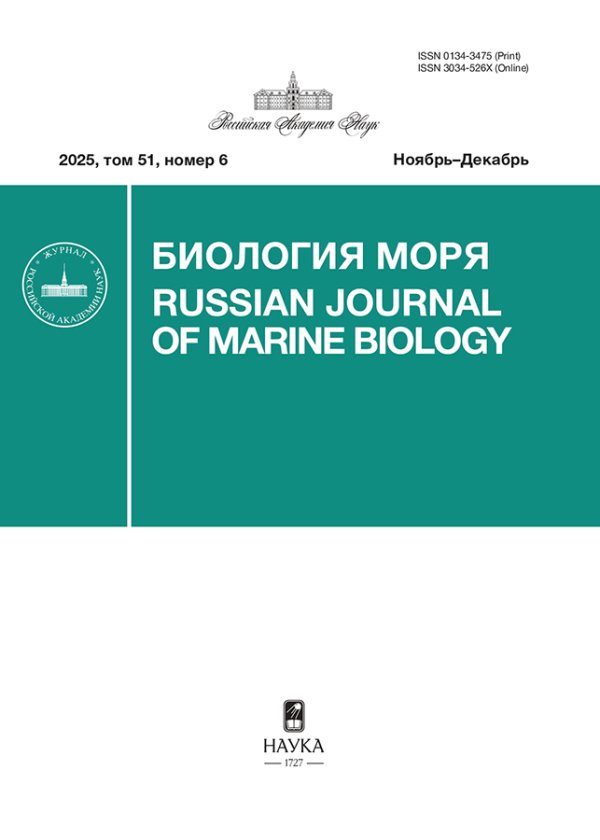Influence of Zinc and Iron on Population Growth and Physiological State of Microalgae Heterosigma akashiwo (Raphidophyceae)
- Authors: Markina Z.V.1, Ognistaya A.V.1
-
Affiliations:
- Zhirmunsky National Scientific Center of Marine Biology, Far Eastern Branch, Russian Academy of Sciences
- Issue: Vol 49, No 4 (2023)
- Pages: 275-280
- Section: КРАТКИЕ СООБЩЕНИЯ
- Published: 01.07.2023
- URL: https://journals.rcsi.science/0134-3475/article/view/135144
- DOI: https://doi.org/10.31857/S0134347523040071
- EDN: https://elibrary.ru/UQLWXU
- ID: 135144
Cite item
Full Text
Abstract
It was studied the influence of zinc and iron at concentrations of 50 and 100 µg/L on cell number, chlorophyll a fluorescence, content of photosynthetic pigments and reactive oxygen species, as well as neutral lipids in the raphidophyte algae Heterosigma akashiwo. Zinc has been found to act on physiological and biochemical processes without affecting the population dynamics of microalgae. It was revealed the negative effect of iron on the fluorescence of chlorophyll a, number of photosynthetic pigments, reactive oxygen species and neutral lipids. The most toxic metal for H. akashiwo turned out to be iron. It was shown that the concentrations of the studied metals do not contribute to the development of H. akashiwo “blooms”.
About the authors
Zh. V. Markina
Zhirmunsky National Scientific Center of Marine Biology, Far Eastern Branch, Russian Academy of Sciences
Author for correspondence.
Email: zhannav@mail.ru
Russia, 690041, Vladivostok
A. V. Ognistaya
Zhirmunsky National Scientific Center of Marine Biology, Far Eastern Branch, Russian Academy of Sciences
Email: zhannav@mail.ru
Russia, 690041, Vladivostok
References
- Качество морских вод по гидрохимическим показателям. Ежегодник 2020 / под ред. А.Н. Коршенко. М: Наука. 2021. 281 с.
- Alemán-Nava G.S., Cuellar-Bermudez S.P., Cuaresma M. et al. How to use Nile Red, a selective fluorescent stain for microalgal neutral lipids // J. Microbiol. Methods. 2016. V. 128. P. 74–79.
- Bornman E., Adams J.B., Strydom N.A. Algal blooms of Heterosigma akashiwo and Mugilidae gill alterations // Estuaries and Coasts. 2022. V. 45. P. 1674–1687.
- Dursun F., Taş S., Koray T. Spring bloom of the raphidophycean Heterosigma akashiwo in the Golden Horn Estuary at the northeast of Sea of Marmara // Ege J. Fish. Aquat. Sci. 2016. V. 33. P. 201–207.
- Gomes F., Ferdandes E., Lima J.F.L.C. Fluorescence probes used for detection of reactive oxygen species // J. Biophys. Biochem. Methods. 2005. V. 65. P. 45–80.
- Guillard R.R.L., Ryther J.H. Studies of marine planktonic diatoms. 1. Cyclotella nana Hustedt, and Detonula confervacea (Cleve) Gran // Can. J. Microbiol. 1962. V. 8. P. 229–239.
- Hyka P., Lickova S., Přibyl P. et al. Flow cytometry for development of biotechnological processes with microalgae // Biotechnol. Adv. 2013. V. 31. P. 2–16.
- Jeffrey S.T., Humphrey G.F. New spectrophotometric equations for determining chlorophylls a, b, c1 and c2 in higher plants, algae and natural phytoplankton // Biochemie und physiologie der pflanzen. 1975. V. 167. № 2. P. 191–194.
- Kayser H. Effect of zinc sulphate on the growth of mono-and multispecies cultures of some marine plankton algae // Helgoländer wissenschaftliche Meeresuntersuchungen. 1977. V. 30. № 1. P. 682–696.
- Kumar K.S., Dahms H.U., Won E.J. et al. Microalgae – a promising tool for heavy metal remediation // Ecotoxicol Envir Safety. 2015. V. 113. P. 329–352.
- Lemley D.A., Adams J.B., Rishworth G.M., Purdie D.A. Harmful algal blooms of Heterosigma akashiwo and environmental features regulate Mesodinium cf. rubrum abundance in eutrophic conditions // Harmful Algae. 2020. V. 100. Art. 101943.
- Martínez-Ruiz E.B., Martínez-Jerónimo F. Nickel has biochemical, physiological, and structural effects on the green microalga Ankistrodesmus falcatus: an integrative study // Aquat. Toxicol. 2015. V. 169. P. 27–36.
- Masmoudi S., Nguyen-Deroche N., Caruso A. et al. Cadmium, copper, sodium and zinc effects on diatoms: from heaven to hell – a review // Cryptogamie Algologie. 2013. V. 34. P. 185.
- Nagajyoti P.C., Lee K.D., Sreekanth T.V.M. Heavy metals, occurrence and toxicity for plants: a review // Envir. Chem. Let. 2010. V. 8. № 3. P. 199–216.
- Rana M.S., Prajapati S.K. Resolving the dilemma of iron bioavailability to microalgae for commercial sustenance // Algal Research. 2021. V. 59. Art. 102458.
- Wan M., Jin X., Xia J. et al. The effect of iron on growth, li-pid accumulation, and gene expression profile of the freshwater microalga Chlorella sorokiniana // Appl. Microbiol. Biotechnol. 2014. V. 98. № 22. P. 9473–9481.
- Yang J., Cao J., Xing G. et al. Lipid production combined with biosorption and bioaccumulation of cadmium, copper, manganese and zinc by oleaginous microalgae Chlorella minutissima UTEX2341 // Biores. Technol. 2015. V. 175. P. 537–544.












